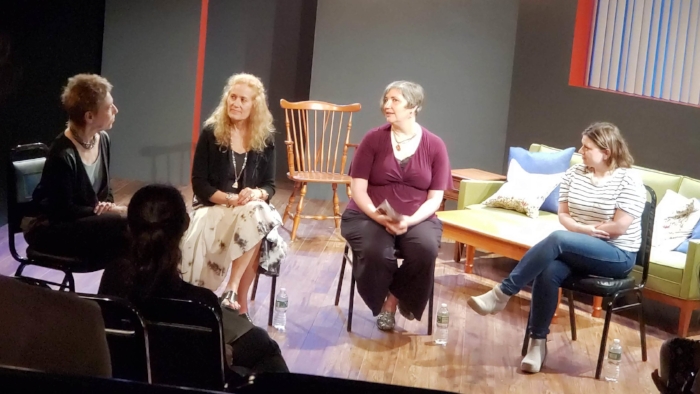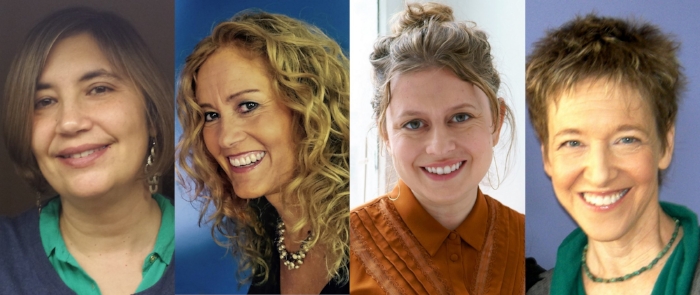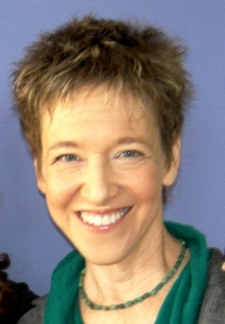Following the May 26 matinee performance of BUMP, Chiara Atik's lively new comedy, EST/Sloan assembled a panel to discuss several of the compelling issues about childbirth the play addresses. Joining playwright Chiara Atik for this discussion were Rebecca Tannenbaum, Senior Lecturer in History from Yale University, and doula trainer Debra Pascali-Bonaro. Journalist Robin Marantz Henig moderated the talkback.
BUMP explores women’s evolving understanding of and control over the birthing process through three stories: a young first-time mother giving birth in colonial New England with the help of an experienced and peppery midwife; five women sharing quips, gripes and observations on an online message board; and a grandfather-to-be getting inspired to invent a device that could revolutionize how infants in difficulty get delivered (a storyline inspired by the experiences of Jorge Odón).
What follows are some of the highlights from the discussion. (Recap by Rich Kelley)
On the inspiration for the play
Robin Marantz Henig: What I love about this play is that you chose this emotional topic. It was very moving and very beautifully done. What made you want to write about this?
Chiara Atik: Pregnancy and childbirth are things that a lot of my friends are going through right now. I'm at the age where people are starting to have kids or certainly starting to think about having kids, so it's a topic that comes up a lot. I was inspired by the article in The New York Times in 2013 about Jorge Odón, the real-life inspiration for Luis in the play. Odón invented this fabulous machine to assist mothers in deliveries. I thought that would make a great Sloan play — Sloan supports plays about science — then I incorporated the other stories.
Robin: What about the colonial story? Did you put that in there to give us a longer view of the history of childbirth?
Chiara: For me, it was an exercise in imagining what it would be like to be pregnant without Google, without a message board, without constant information at your fingertips, or even, in the case of our story, family support, which I think was rare even for the time ... In those days, most people likely had a lot of family, had big support systems; Mary doesn't. I wanted to show the opposite extreme. The Internet really influences the other two storylines and, thematically, just how much information you have: whether you have too much, whether you have too little, how it influences the experience.
Robin: So, Chiara, the message board: How did that come to you? Did you want all good feelings, or sort of a combination of old wives' tales and natural information?
Chiara: Yeah, definitely a combination. The message board, it's less about the specific kernels of information, which sometimes can be helpful and sometimes can be the least helpful thing in the world, and more about the feeling of community and feeling like you're not in this alone. You're a team: They're going through this experience at the exact same rate at the exact same time and I think that even pre-Internet groups like that were very helpful. I wanted a sort of a Greek chorus of the whole experience, or aspects of the experience. So, again, it's less about "Well, I got this information," and more about other people.
Robin: Sharing
Chiara: Sharing, yeah.
On the historical accuracy of the colonial storyline
Robin: Rebecca, is that how the birth would have gone in colonial times? The character had so little information: she thought she was going to have a pain and then have a baby. And she had no interaction with her midwife before she arrived that night... It was interesting that she was sitting in a chair when she was actually giving birth.
Rebecca Tannenbaum: Yeah, I thought that was actually quite accurate. We have this image of the woman today — many of us who have given birth did it this way ourselves — you lie on a table on your back, but that's not how women have given birth for a long time. Certainly, in the colonial period, many midwives had birthing stools: special chairs with a hollowed-out seat and a lower seat for the midwife to sit on and catch the baby. Giving birth upright would've been the standard practice for that time and right up until the nineteenth century when physicians started performing a lot of births.
Another thing that struck me as very accurate was the walking because the walking was definitely something that midwives would encourage women to do: to keep moving; to not lie still because movement helps encourage the contractions as well. But one of the things about birthing in the colonial period, which came out in the play as well, was this idea that it was meant to be painful; that women were meant to suffer in birth. The biblical references that the midwife gave to Mary were very much the way birth was understood in the seventeenth and eighteenth centuries: that this is part of woman's lot for being a daughter of Eve and that the fear and pain was just something you had to accept as punishment for Original Sin.
Robin: Was it typical to bring a midwife in? Because the way she said, "We're paying you a lot for this; why are you going away?" almost seemed like it was a mark of being different from her neighbors.
Rebecca: Women certainly counted on having a midwife there: someone who was experienced; someone who could help them. So, it wouldn't have been unusual at all. What would've been unusual would've been having a male physician attend the birth. And as time passed, and as you got into the late eighteenth century and early nineteenth century, having a male physician actually became a status symbol. You start to see it first in urban areas among wealthy clientele. Part of it was just, like, "I have this doctor who was trained in Europe," and that's better news, but part of it also was that it was true that, beginning around the 1780s, 1790s, physicians could offer technology, like the forceps, that midwives could not. The fear the mother in the play showed was also pretty accurate for the colonial period, so having the reassurance that you had a practitioner who could offer this new technology that could pull a baby out without danger to the baby or the mother was something that people who could afford it really wanted.
Robin: Did this midwife pull out forceps?
Rebecca: Yes, I know noticed that she had forceps.
Chiara: Yes.
Robin: Why did she ... Was she really going to use it on the baby?
Chiara: Yeah, they were there as a measure. And that was more of a dramatic choice than . . .
Robin: But perhaps not historically accurate?
Rebecca: Yeah, not historically accurate. It would have been a formally-trained physician who used forceps.
Chiara: Right.
Rebecca: It became kind of controversial, whether you would allow a man in the birthing room, seeing a woman in this intimate way, and one of the titles of one of the pamphlets that was actually advocating for midwife birth was "Hands of Flesh vs Hands of Iron." "What do you want touching you: hands of flesh or hands of iron?"
Chiara: Wow.
On the evolution of how babies are delivered
Adriana Sananes (who plays Maria in the play and who joined the audience for the talkback): Did I hear correctly that when physicians started doing the births, that's when women started lying down?
Rebecca: Yes, because it's easier for them to see what's happening ... easier for them to use their forceps ...
Adriana: And that's more or less what time?
Rebecca: The late eighteenth, early nineteenth century, so between 1780 and 1820.
Debra Pascali-Bonaro: Isn't that phenomenal to know? Whose comfort? The doctor’s? Not the person giving birth. How crazy is that? And that we have all the data to say it's actually harmful to lay down and push your baby out, and yet we're still doing it against the best science.
Adriana: That’s the reason for my question. I went through 27 hours of intense contractions in labor. And a lot of the time, I was laying down with all these things and the doctor kept telling me, "The baby's fine. The baby's fine." And it's like, "But I'm the one ..." [laughter] So I was wondering when that whole aspect of the physician telling me ...
Rebecca: Well, the reason you had to be lying down is because you had all the monitors attached.
Adriana: Exactly, exactly. I wasn't dilating, but still, it was incredible to just ... Your instinct is to walk. Breathe and walk and breathe and walk.
On home births, birth centers, and hospitals
Audience member: In the play the colonial mother has a home birth and Claudia wants to have a home birth. What is your feeling about having home births today?
Debra: I attend many home births in the New York/New Jersey area, and we have wonderful qualified licensed midwives for home birth. I think home birth is growing, and there is misinformation out there, but home birth for low-risk women is quite safe, and that's the midwife's role: to keep that safe and transfer, when needed, to a hospital. So as long as you're here in New York you're always thirty minutes from a hospital, but as long as you can transfer in time if you need extra care, home birth is very safe.
Robin: And how about birthing centers? Is that a big midway thing?
Debra: They are wonderful. The sad thing here in New York is we don't have many of them. Due to different regulations and licensing. But other states do have more birth centers, and birth centers are growing around the U.S. In the U.K. they have many birth centers. Good home birth rate, birth centers ... ultimately, that's what we need so people have the choice of where you feel safe, whether that's home, birth center, or hospital.
Audience member: What do you recommend women do in a hospital scenario?
Debra: First, have a doula because a doula is really trained to navigate that, and doulas facilitate communication between the person giving birth and the team. We don't speak for anyone, but we amplify their voice. So we don't let anyone do anything that isn't really engaging them and ultimately, we need to bring home birth into the hospital. I teach at medical schools and midwifery schools, and I'm teaching bringing back the wisdom of our great grandmothers that knew how to do all these comfort measures. We've got to overhaul the system so that this is available. But in the short term where our system is still dysfunctional, bring a doula with you and get educated! A lot of people, like the message board, are passing some good information, but also some misinformation. And a lot of people that think they know a lot about birth that are pregnant actually don't always know what they think they know. I’m an advocate that, especially first-time mothers, get into a really good childbirth class ... not in most hospitals though, because hospital classes ... Sorry, I'm biased, but I think a lot of them are for patient compliance: They really teach you what they want you to do to be a good patient, and they don't really teach you your options. Then again, you're being led onto the assembly line of industrialized childbirth, and it's not about you. It's about getting you through the system.
On the difference between a doula and a midwife
Robin: Debra, you’re a doula, not a midwife. Can you explain what the difference is?
Debra: Chiara, you mentioned "doula" in the play. I loved that. I lit up. So looking "herstorically," women had other women that were around them. A doula really is reconnecting that circle of support of females. Sadly, we don't attend each other's births anymore. We would've known how to do that back then, but now we have to go to a workshop and relearn those skills. So a "doula" isn't really new; it's really rediscovering the role of women supporting women. Just like women's menstrual cycles come together when they live or work together, we're starting to learn that women have a physiology among each other. And the studies show that even the most wonderful, loving male, sorry to say, but he doesn't make labor any easier or less of an intervention.
When you bring another woman, who's trained in the natural comfort ways, labor actually is shorter and with less interventions. A doula is just offering that emotional, physical support. If there's religious or spiritual practices, they're integrating them, but doulas don't do any medical skills. And the midwife is really the keeper of that, making sure mother and baby are healthy and well. A doula is really like a sister, your best friend, being at the birth with you.
On the potential usefulness of the Odón Device
Robin: Debra, can you talk a little bit about this device that sort of yanks the baby out?
Debra: I have this double-edged kind of look at it: On one side, I think that we've gone so far that we just keep making mothers lie down today to give birth. We have a fascination with getting the baby out in positions that don't work, so we are doing too much assisted birth. I'd hate to see us, now, create another technology that just again indulges our fascination with how we can get a baby out without physiology. But I am kind of interested in it because it sounds like it's gentler than the alternative, if we use it appropriately.
Audience member: Debra, I hear your reservations about the Odón device. But you've had so much experience in attending so many childbirths around the world ... Do you think something that's as low-tech as the Odón device could make a difference in low-resource environments?
Debra: Oh, I do. And that's why I said it's double-edged: I think when you truly have a baby that's having trouble getting out you need to change positions a lot ... A baby being born is — it may be a bad analogy but it may help explain — it’s like a lock and key. If you put the key in upside-down, it doesn't matter how long you push: you won't open the door. You'll eventually cut the door down. So all around the world, we always say "four to five pushes in a position" and if we're not making movement, we change again. In some places in the world, we're moving and moving and moving, because you move the mother, and it moves the baby. And we get all the babies out! So when we put people in a hospital and put them on their back, and then we're going to randomize a trial, you are going to have babies that are going to get stuck because we're not using gravity and we're not moving the mother, then I think we are just using more technology without really needing to. But if really just use it in the rare cases, then I think it's valuable.
Audience member: And you could envision a doula or a midwife doing this?
Debra: Not a doula. Let’s remain historic. Doulas don't do any medical care.
Audience member: Not even that. Okay.
Debra: That’s the question. Around the world where if you're in really low-resource areas where we don't have access to doctors, will they then train the midwives in that? Although the midwives who use lots of positions will have a very, very, very low rate of babies that get stuck.
The 2018 EST/Sloan Mainstage Production, BUMP by Chiara Atik began previews at the Ensemble Studio Theatre on May 9 and completed its run on June 3, 2018.

















